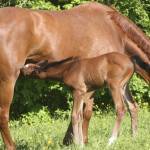Foal Heat Diarrhea Studied

Mares come into estrus about seven to 14 days after giving birth. This period coincides with the occurrence of diarrhea in about 80% of foals, hence the name “foal heat diarrhea.” There is no certain explanation as to why foals get diarrhea at this time, and various possible causes—influence of hormonal changes in mare’s milk, foal begins to eat mare’s manure, bacterial infection, parasite infestation—have been advanced. Opinions differ as to whether the diarrhea (also known as “scours”) should be seen as an illness or just as a normal phase of foal development. In most foals the condition lasts only a few days and clears up without treatment. However, a few foals become severely ill, some experience growth delays, and a small number die. This study looked at the possible relationship between Cryptosporidium parvum and foal heat diarrhea.
How was the study conducted?
The study group was made up of 30 newborn foals and their dams. Seventeen foals were males and 13 were females. Mares were from five to 20 years old. All animals were considered healthy based on veterinary examination prior to the study period. Mares and foals were kept indoors, and none received medical treatment for the duration of the study.
Blood samples collected from two-day-old foals were analyzed for immunoglobulins as a measure of passive transfer of immunity obtained from colostrum intake. Rectal swabs were collected from mares and foals when foals were two to three days old; during periods of foal diarrhea; during mare’s estrus period; and when foals were a month old. These swabs were examined for Escherichia coli, Clostridium perfringens, and Salmonella enterica.
Fecal samples were collected from both mares and foals during periods of foal diarrhea and mares’ estrus periods. The samples were examined for parasite eggs, Giardia organisms, and Cryptosporidium organisms.
What results were found?
Twenty-four of 30 foals (80%) developed diarrhea at seven to ten days of age. Foals with and without diarrhea showed the same levels of E. coli and C. perfringens, and levels of these bacteria were within normal limits in all mares. No mares or foals were positive for the common equine parasites (giardia, coccidia, strongyles) for which they were screened. Salmonella, a common cause of diarrhea in older foals, was not found in any samples.
Passive transfer of immunity, as determined by the zinc sulfate turbidity test, was at an acceptable level in all foals. However, this test may not be sensitive enough to determine whether some foals might have had slightly less than optimal immunity. C. parvum was not found in any mares. Among the foals in the study, 12 were found to have C. parvum. Of these, ten had diarrhea and two were healthy.
What conclusions were reached?
The results indicate that C. parvum infection may have some relation to foal heat diarrhea in young foals. Because C. parvum was also found in some foals that did not exhibit diarrhea, it is probable that the cause of foal heat diarrhea may involve more than one factor. The authors point out that this study was limited by small sample size, and that further research will be needed to clarify the role of C. parvum in foal heat diarrhea.
The full text of this article can be found in Ippologia, Anno 14, n. 4, Dicembre 2003, pp. 5-9.
The study “Cryptosporidiosis and foal heat diarrhea,” was conducted by M Sgorbini, M Corazza, C D’Agostino, S Perrucci, and L Giorgi.
NOTE: While many cases of foal heat diarrhea clear up within a few days, severe or prolonged diarrhea in foals of any age may result in serious dehydration within six to eight hours. Foals with diarrhea should be closely monitored, and veterinary evaluation and treatment may be indicated.
One of the best defenses against infection is ensuring that newborn foals ingest a sufficient quantity of colostrum. In order for the mare to produce the necessary antibodies, she should receive all scheduled vaccinations and should be moved to the foaling premises at least four to six weeks before giving birth.








